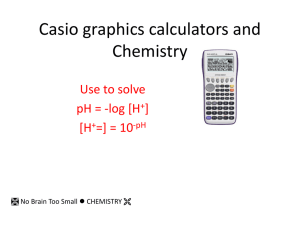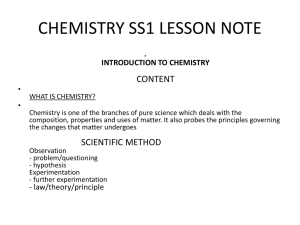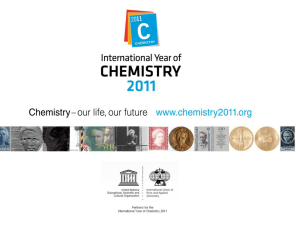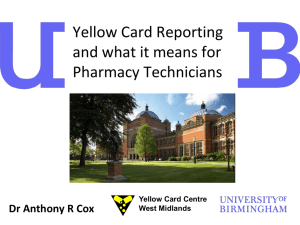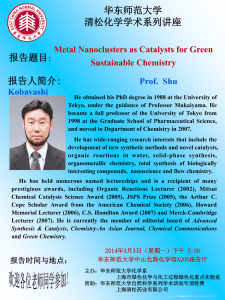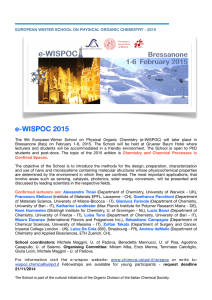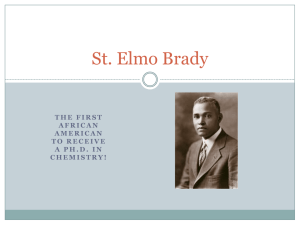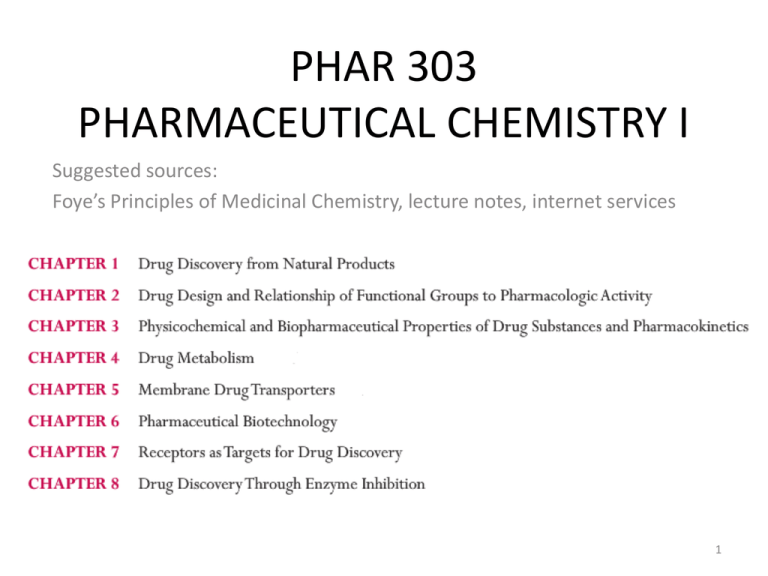
PHAR 303
PHARMACEUTICAL CHEMISTRY I
Suggested sources:
Foye’s Principles of Medicinal Chemistry, lecture notes, internet services
Outline of the source:
1
2
What is Medicinal Chemistry?
• Medicinal chemistry is the chemistry discipline
concerned with the design, development and synthesis
of pharmaceutical drugs. The discipline combines
expertise from chemistry and pharmacology to identify,
develop and synthesize chemical agents that have a
therapeutic use and to evaluate the properties of
existing drugs.
3
Med Chem research areas
•
•
•
•
•
•
•
Drug candidate design (discovery)
Drug and drug candidate synthesis (discovery)
Structure identification (discovery)
Drug metabolism studies
Pharmacological activity screening
Chemical basis of drug bioactivation
Chemical Targeting
4
A few words on historical development
• The removal of spiritual believes in people’s minds and thinking
scientifically clearly acclerated the development of various science
including medicinal chemistry.
• The source of folk medicine: The oldest records of the use of
therapeutic plants and minerals are derived from the ancient
civilizations of the Chinese, the Hindus, the Mayans of Central
America, and the Mediterranean peoples of antiquity.
• The 19th Century: The 19th century saw a great expansion in the
knowledge of chemistry, which greatly extended the herbal
pharmacopeia that had previously been established.
• The 20th Century: The development of pharmaceutical industry and
medicinal chemistry.
5
A few words on historical development
•
•
•
The 19th century may be viewed as the birth period of modern medicinal
chemistry with the introduction of side chain theory of drug action in 1885 by
Berlin immunologist Ehrlich. Later in 1891, he coined the term chemotherapy
and defined it as “the chemical entities exhibiting selective toxicities against
particular infectious agent. The modern drug receptor theory originated from
this side chain theory, which was supported during the same period (mid1890s) by Cambridge physiologist Langley who described it in his publications
as “receptive substances.”
Research on enzyme specificity (lock-and-key theory) by Fischer in 1894 and
Henry's hypothesis on enzyme-substrate complex formation in 1903 are
recognized as key advancements in the principles of drug action and modern
medicinal chemistry.
Grimm's and Erlenmeyer's concepts of isosterism and bioisoterism (19291931) also had a tremendous impact on the understanding of structure
activity relationship (SAR) of drugs and development of modern medicinal
chemistry.
6
A few words on historical development
• Other notable advancements in understanding of drug action and design
that were made in the mid to late 20th century include: intervention of
charge transfer (Kosower, 1955); induced-fit theory of drug action
(Koshland, 1958); concepts of drug latentiation (Harper, 1959) and
prodrug (Albert, 1960); application of mathematical methods to medicinal
chemistry and transformation of SAR studies into quantitative SAR (QSAR)
(Hansch and others, 1960s); and application of artificial intelligence to
drug research (Chu, 1974).
7
What is now for med chem?
• Medicinal chemistry is defined as an interdependent mature
science that is a combination of applied (medicine) and basic
(chemistry) sciences. It encompasses the discovery,
development, identification, and interpretation of the mode of
action of biologically active compounds at the molecular level.
Medicinal chemistry may be viewed as the melting pot of
synthetic chemistry and molecular pharmacology that
emphasizes the study of SAR of drug molecules; it therefore
requires a clear understanding of both chemical and
pharmacological principles.
8
Intellectual Domains of Medicinal Chemistry: Scopes
and Importance in Pharmacy
•
The 2 intellectual domains of medicinal chemistry that are of value in
pharmacy are drug design and development and ADMET (absorption,
distribution, metabolism, excretion, and toxicity) assessments. Interpretation
of mode of action at the molecular level and construction of SAR of drug
molecules or biologically active compounds are important scopes of the drug
design and discovery domains, which in turn are vital facets of medicinal
chemistry. Additionally, ADMET assessments of therapeutic drug classes that
have a significant influence on therapeutic decision making are essential
components of pharmacy education. As experts in the therapeutic use of
medications and pharmaceutical care, pharmacists routinely provide
therapeutic evaluations, recommendations, and counseling to patients and
other health care professionals regarding safe, appropriate, and cost-effective
use of medications. With current emphasis on intense clinical training,
pharmacists also are equipped with skills to evaluate scientific literature and
develop evidence-based patient-specific pharmacotherapy plans. Thus, by
offering a sound knowledge base of the chemical basis of drug action, its
stability, SAR, mechanism of action, pharmacology, and ADMET, medicinal
chemistry instills critical-thinking and problem-solving skills in students that
are essential for the making of a competent pharmacist.
9
Drug Discovery from Natural Products
• Historically, the majority of new drugs have been generated from
natural products (secondary metabolites) and from compounds
derived from natural products. Natural products and their derivatives
have been and continue to be rich sources for drug discovery.
However, natural products are not drugs. They are produced in
nature and through biological assays they are identified as leads,
which become candidates for drug development.
• More than 60% of the drugs that are in the market derive from
natural sources. During the last two decades, research aimed at
exploiting natural products as a resource has seriously declined.
This is in part due to the development of new technologies such as
combinatorial chemistry, metagenomics and high-throughput
screening.
10
Medicinal Plants in Folklore
• The use of natural products as medicines has been described
throughout history in the form of traditional medicines, remedies,
potions and oils with many of these bioactive natural products still
being unidentified. The dominant source of knowledge of natural
product uses from medicinal plants is a result of man experimenting
by trial and error for hundreds of centuries through palatability trials
or untimely deaths, searching for available foods for the treatment of
diseases.
• This is the main topic of Pharmacognosy. More specific examples
afre given in the related lecture series.
11
Primary and Secondary Metabolites (Natural Products)
• The biosynthesis and breakdown of proteins, fats, nucleic acids and
carbohydrates, which are essential to all living organisms, is known
as primary metabolism with the compounds involved in the
pathways known as “primary metabolites”.
• The mechanism by which an organism biosynthesizes compounds
called ‛secondary metabolites’ (natural products) is often found to be
unique to an organism or is an expression of the individuality of a
species and is referred to as “secondary metabolism”. Secondary
metabolites are generally not essential for the growth, development
or reproduction of an organism and are produced either as a result
of the organism adapting to its surrounding environment or are
produced to act as a possible defense mechanism against predators
to assist in the survival of the organism.
12
Some examples on Historically Important Natural
Products
Acetylsalicyclic acid (1), Salicin (2), Morphine (3), Digitoxin (4), Quinine (5) Pilocarpine (6).
Acetylsalicyclic acid (1) (aspirin) derived from
the natural product, salicin (2) isolated from
the bark of the willow treeSalix alba L.
Investigation of Papaver somniferum L. (opium
poppy) resulted in the isolation of several
alkaloids including morphine (3),
Digitalis purpurea L. Has the active constituent
digitoxin (4), a cardiotonic glycoside that
enhances cardiac conduction, thereby
improving the strength of cardiac ontractibility
The anti-malarial drug quinine (5) isolated
from the bark of Cinchona succirubra
Pilocarpine (6) found in Pilocarpus jaborandi
(Rutaceae) is an L-histidine-derived alkaloid,
which has been used in the treatment of
chronic open-angle glaucoma.
13
Preparation of Initial Extracts and Preliminary
Biologic Screening
• It is typical to extract initially terrestrial plants with a polar solvent like
methanol or ethanol, and then subject this to a defatting (lipidremoving) partition with a nonpolar solvent like hexane or petroleum
ether, and then partition the residue between a semipolar organic
solvent, such as chloroform or dichloromethane, and a polar
aqueous solvent.
• A peculiarity of working on plant extracts is the need to remove a
class of compounds known as “vegetable tannins” or “plant
polyphenols” before subsequent biologic evaluation because these
compounds act as interfering substances in enzyme inhibition
assays, as a result of precipitating proteins in a nonspecific manner.
• Caution also needs to be expressed in regard to common saturated
and unsaturated fatty acids that might be present in natural product
extracts, because these may interfere with various enzyme inhibition
and receptor binding assays.
14
Preparation of Initial Extracts and Preliminary Biologic
Screening
• HTS: high-throughput screening
Drug discovery from organisms is a “biology-driven” process, and as
such, biologic activity evaluation is at the heart of the drug discovery
process from crude extracts prepared from organisms. So-called highthroughput screening (HTS) assays have become widely used for
affording new leads. In this process, large numbers of crude extracts
from organisms can be simultaneously evaluated in a cell-based or
non-cell-based format, usually using multiwell microtiter plates.
Cell-based in vitro bioassays allow for a considerable degree of
biologic relevance, and manipulation may take place so that a selected
cell line may involve a genetically altered organism or incorporate a
reporter gene. Innoncellular (cell-free) assays, natural products extracts
and their purified constituents may be investigated for their effects on
enzyme activity or on receptor binding.
For maximum efficiency and speed, HTS may be automated through
the use of robotics and may be rendered as a more effective process
through miniaturization.
15
Methods for Compound Purification and Structure
Elucidation and Identification
• Bioassay-directed fractionation is the process of isolating pure active
constituents from some type of biomass (e.g., plants, microbes,
marine invertebrates) using a decision tree that is dictated solely by
bioactivity.
• Recent improvements have been made in column technology,
automation of high-performance liquid chromatography (HPLC; a
technique often used for final compound purification), and
compatibility with HTS methodology. Routine structure elucidation is
performed using combinations of spectroscopic procedures, with
particular emphasis on 1H- and 13C-nuclear magnetic resonance
(NMR) spectroscopy and mass spectrometry (MS).
16
Compound Development
• A major challenge in the overall natural products drug discovery
process is to obtain larger amounts of a biologically active
compound of interest for additional laboratory investigation and
potential preclinical development. One strategy that can be adopted
when a plant-derived active compound is of interest is to obtain a
recollection of the species of origin. To maximize the likelihood that
the recollected sample will contain the bioactive compound of
previous interest, the plant recollection should be carried out in the
same location as the initial collection, on the same plant part, at the
same time of the year.
17
Compound Development
• Once a bioactive natural product lead is obtained in gram quantities,
it is treated in the same manner as a synthetic drug lead and is thus
subjected to pharmaceutical development, leading to preclinical and
clinical trials. This includes lead optimization via medicinal
chemistry, combinatorial chemistry, and computational chemistry, as
well as formulation, pharmacokinetics, and drug metabolism studies,
as described elsewhere in this volume. Often, a lead natural product
is obtained from its organism of origin along with several naturally
occurring structural analogs, permitting a preliminary structure–
activity relationship study to be conducted.
18

